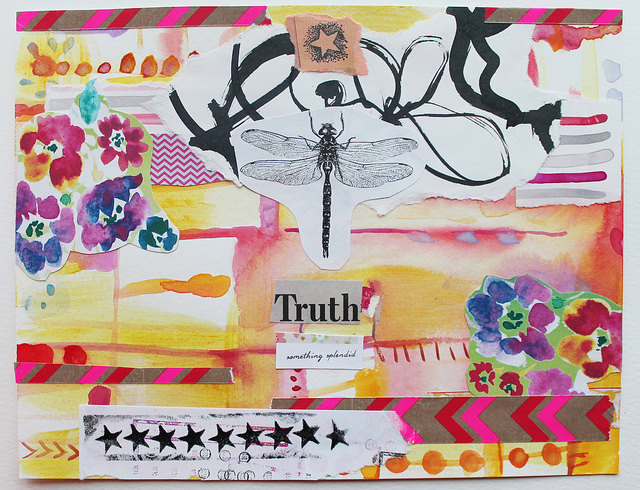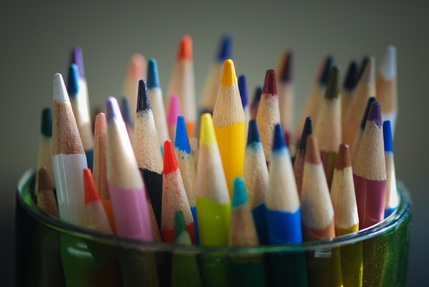Express yourself visually
Whether it’s doodling randomly with a Sharpie or spreading paint across a canvas, engaging in a visual medium during psychiatric drug withdrawal can serve as anything from a needed distraction to a deeply therapeutic process. So-called talent is not a prerequisite, and the medium can be whatever you’re drawn to at the moment or spring from whatever materials you have available.
Among people who worked in an art medium before withdrawal, some report having periods of time when they find it difficult or impossible to access their skill, creativity, or motivation as they used to. Some may change the way they work temporarily, or they may take a break for a while, or they may have windows periodically during which they’re able to produce striking art that in some way reflects or is deepened by their experience.
Here are just a few types of visual expression that people in withdrawal have found diverting or satisfying:
Create a photo collage.
 Some people find that taking photos with a camera or phone is a useful distraction during withdrawal. The act of focusing and framing an image has a way of drawing your attention to the outside world in a manner that’s containable and controllable. The process might be simply a matter of taking a photo of whatever catches your eye and saving each image on a phone or computer. When you look back at the images over time, they may remind you of where you were at a given moment or how you felt.
Some people find that taking photos with a camera or phone is a useful distraction during withdrawal. The act of focusing and framing an image has a way of drawing your attention to the outside world in a manner that’s containable and controllable. The process might be simply a matter of taking a photo of whatever catches your eye and saving each image on a phone or computer. When you look back at the images over time, they may remind you of where you were at a given moment or how you felt.
Whenever you choose to, the photos can be shuffled around in an order that has personal meaning or simply speak for themselves. If you wish, it’s possible to create photo collages online using a program such as this one.
Alternatively, photos can be printed out, arranged, and glued on a backing such as heavy paper, poster board, or canvas. Some people find that making a photo collage can help document their withdrawal journey and serve as a reminder of progress and strength.

Make an art collage.
Similar to the process above, crafting an art collage entails juxtaposing imagery in whatever way you choose. There are no rules, and the process can be just as beneficial as the end product. Simply gather materials that appeal to you, whether they be pictures or words from old magazines or newspapers, fabric scraps, memorabilia, greeting cards or postcards, wrapping paper, paint, markers, buttons, ribbons, feathers, flat rocks or shells—the sky’s the limit, as long as the material can be glued or applied onto a backing of some sort. For the backing you could try heavy paper (if it’s strong enough), poster board, canvas, cardboard, inexpensive plywood, or whatever you think might work. If you’re hoping to keep your collage into the future, you might want to research the materials you’re using to make sure they’ll stand the test of time.
Color away. 
It may be a runaway trend, but putting colored pencils or markers or even crayons to work inside a coloring book has proved for many to be a calming distraction from withdrawal symptoms. Inside or outside the lines, it doesn’t matter. Some people find the idea a bit silly, but others see it as a helpful way to lessen anxiety or distract from looping negative thoughts. For an extra bit of relaxing input, you might try coloring outdoors in the fresh air or at a table with soft music in the background. A coloring book designed for adults (mandalas are popular) and a set of colored pencils or markers can often be purchased online or found in bookstores, gift stores, arts and craft stores, or other retail outlets for under $10.
Pick up a paintbrush.
 The experience of applying paint to a canvas or page can be a satisfying one whether you’re trying it for the first time or continuing a practice that you’ve done for years. During withdrawal, some people use painting for nothing but the therapeutic value of the process, while others find that they’re able to create something that has richness and meaning (and it’s not unusual to experience both, depending on where you are in the course of withdrawal). The type of materials you choose will vary widely according to your experience level, your space, and what you can afford. For those who like the feel of a brush and paint but not the idea of staring at a blank canvas, you might try looking for a paint-by-numbers kit online—some find they offer a quaint appeal or evoke a positive childhood memory.
The experience of applying paint to a canvas or page can be a satisfying one whether you’re trying it for the first time or continuing a practice that you’ve done for years. During withdrawal, some people use painting for nothing but the therapeutic value of the process, while others find that they’re able to create something that has richness and meaning (and it’s not unusual to experience both, depending on where you are in the course of withdrawal). The type of materials you choose will vary widely according to your experience level, your space, and what you can afford. For those who like the feel of a brush and paint but not the idea of staring at a blank canvas, you might try looking for a paint-by-numbers kit online—some find they offer a quaint appeal or evoke a positive childhood memory.
Call it a draw(ing).
Whether it’s doodling, inventing cartoons, sketching a still life, or creating a portrait, many have found that drawing can be helpful when coping with symptoms of withdrawal. If you’re stuck for ideas or inspiration, one technique that some find diverting is trying a contour drawing—looking only at the subject or object you’re drawing rather than your hand, and not lifting your pencil or marker off the page until you’re done. The idea is to imagine you’re tracing along the outlines of the subject itself—and when you look at the final product, you may be amused to find that you’ve drawn all the features on one side of a face or created a tangle of flowers that are nowhere near their vase. Whatever type of drawing you prefer, the idea is to keep your mind occupied in a way that appeals to you, whether you end up scribbling something that’s immediately forgotten or creating a lasting piece of art.

Visual expression
Express yourself visually
Whether it’s doodling randomly with a Sharpie or spreading paint across a canvas, engaging in a visual medium during psychiatric drug withdrawal can serve as anything from a needed distraction to a deeply therapeutic process. So-called talent is not a prerequisite, and the medium can be whatever you’re drawn to at the moment or spring from whatever materials you have available.
Among people who worked in an art medium before withdrawal, some report having periods of time when they find it difficult or impossible to access their skill, creativity, or motivation as they used to. Some may change the way they work temporarily, or they may take a break for a while, or they may have windows periodically during which they’re able to produce striking art that in some way reflects or is deepened by their experience.
Here are just a few types of visual expression that people in withdrawal have found diverting or satisfying:
Create a photo collage.
Whenever you choose to, the photos can be shuffled around in an order that has personal meaning or simply speak for themselves. If you wish, it’s possible to create photo collages online using a program such as this one.
Alternatively, photos can be printed out, arranged, and glued on a backing such as heavy paper, poster board, or canvas. Some people find that making a photo collage can help document their withdrawal journey and serve as a reminder of progress and strength.
Make an art collage.
Similar to the process above, crafting an art collage entails juxtaposing imagery in whatever way you choose. There are no rules, and the process can be just as beneficial as the end product. Simply gather materials that appeal to you, whether they be pictures or words from old magazines or newspapers, fabric scraps, memorabilia, greeting cards or postcards, wrapping paper, paint, markers, buttons, ribbons, feathers, flat rocks or shells—the sky’s the limit, as long as the material can be glued or applied onto a backing of some sort. For the backing you could try heavy paper (if it’s strong enough), poster board, canvas, cardboard, inexpensive plywood, or whatever you think might work. If you’re hoping to keep your collage into the future, you might want to research the materials you’re using to make sure they’ll stand the test of time.
Color away.
It may be a runaway trend, but putting colored pencils or markers or even crayons to work inside a coloring book has proved for many to be a calming distraction from withdrawal symptoms. Inside or outside the lines, it doesn’t matter. Some people find the idea a bit silly, but others see it as a helpful way to lessen anxiety or distract from looping negative thoughts. For an extra bit of relaxing input, you might try coloring outdoors in the fresh air or at a table with soft music in the background. A coloring book designed for adults (mandalas are popular) and a set of colored pencils or markers can often be purchased online or found in bookstores, gift stores, arts and craft stores, or other retail outlets for under $10.
Pick up a paintbrush.
Call it a draw(ing).
Whether it’s doodling, inventing cartoons, sketching a still life, or creating a portrait, many have found that drawing can be helpful when coping with symptoms of withdrawal. If you’re stuck for ideas or inspiration, one technique that some find diverting is trying a contour drawing—looking only at the subject or object you’re drawing rather than your hand, and not lifting your pencil or marker off the page until you’re done. The idea is to imagine you’re tracing along the outlines of the subject itself—and when you look at the final product, you may be amused to find that you’ve drawn all the features on one side of a face or created a tangle of flowers that are nowhere near their vase. Whatever type of drawing you prefer, the idea is to keep your mind occupied in a way that appeals to you, whether you end up scribbling something that’s immediately forgotten or creating a lasting piece of art.
Photo of the collage courtesy of Marcia and Flickr Creative Commons.